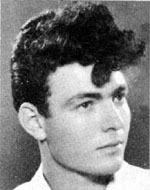Weissberg, Ran (“Rani”)
Son of Issachar and Tzila. One of the first settlers of Afula and its veterans. Ran was born on August 4, 1944, in Afula, where he completed his high school studies at the local high school, belonged to the Hanoar Haoved movement and even to the Gadna-Air. He was gentle and poetic. He could not see the suffering of others, whether man or mother. His devotion and devotion to his friends are remarkable. His great interest in Greek mythology, which he read a lot, should be noted; Among other things, the Epics loved the “Iwata” for Longville. Was a popular figure and a favorite among his friends because of his honesty, humor and varied knowledge. In addition to his love for the city of Emek, his birthplace, he was proud of his parents, whom he admired in secret. His parents moved to Netanya and this uprooting led him to new landscapes and to strong impressions from them. For the family to Netanya, Ran applied for the entrance exams to the Hebrew Technion and was accepted to the structural engineering department within the framework of the academic reserve. In the past year, he received a special permit to study architecture, a second year. After completing his studies and receiving his B.Sc. degree, he was drafted into the IDF in August 1962 to finish his regular service as an officer in the Engineering Corps, while he was studying engineering at the Technion. And he was Simcha to escape from the school table, laden with rulers and drawing sheets, to seek healing in the sights of nature – and in these landscape paintings, which constitute most of his paintings, Ran gave expression to his experiences and feelings. The days of alert for the Six-Day War came – and the horizon was Kedar, who had a few days off to receive his degree Was sent to his unit, and his family received occasional peace, because he was somewhere in the north, and in his home only after the cease-fire, during the short war Ran worked with his men to clear a path under enemy fire to allow passage to the Israeli armor. The Golan Heights, where he had suddenly grown up like all the other warriors, and when the choice was given to a soldier in his unit to engage in an unmanageable job or to join Ran in clearing mines, the soldier would choose the second, as long as he was with his commander. When Ran finished his last vacation at home, he hurried to the railway station to arrive in time, because many plans had been planned for the highlands; The outpost had to rise on the ground, travelers flocked from all sides to witness with their own eyes the Syrian strongholds that threatened the Galilee and see the sources of the Jordan. But this level was a large minefield and cleaning up this area was a vital and difficult task placed on the shoulders of the engineering people. On August 7, 1967, while carrying out his duties, while scanning the area of his miners, somewhere on the Banias slopes, one of the mines exploded and hit Lieutenant Ran – and the parents did not even get to bring their son to the wedding, which was scheduled for 30 August A few weeks later, he was laid to rest in the military cemetery in Netanya, and his parents published a book in his memory called “Ran Weisberg.”
